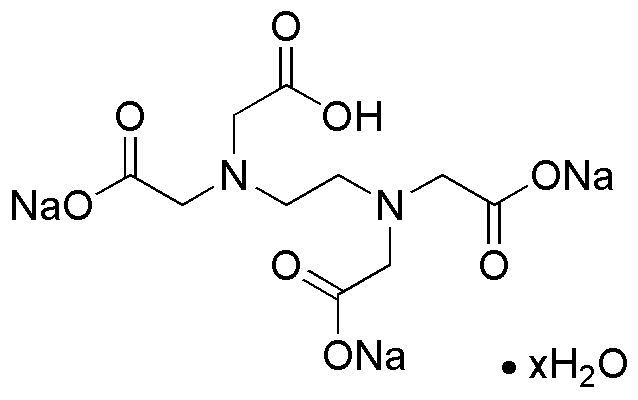Ethylenediaminetetraacetic acid trisodium salt is widely utilized in research focused on:
- Water Treatment: This compound effectively chelates metal ions, making it valuable in water purification processes to remove heavy metals and prevent scaling in industrial systems.
- Food Preservation: Its ability to bind metal ions helps to enhance the shelf life of food products by preventing oxidation, thus maintaining quality and safety in the food industry.
- Pharmaceutical Applications: Used as a stabilizing agent in drug formulations, it ensures the efficacy of active ingredients by preventing metal-catalyzed degradation.
- Laboratory Reagents: Commonly employed in biochemical assays and research, it serves as a buffer and a chelating agent, facilitating various analytical techniques.
- Agricultural Uses: In fertilizers, it aids in the availability of micronutrients to plants by preventing their precipitation, thus improving crop yield and health.
General Information
Properties
Safety and Regulations
Applications
Ethylenediaminetetraacetic acid trisodium salt is widely utilized in research focused on:
- Water Treatment: This compound effectively chelates metal ions, making it valuable in water purification processes to remove heavy metals and prevent scaling in industrial systems.
- Food Preservation: Its ability to bind metal ions helps to enhance the shelf life of food products by preventing oxidation, thus maintaining quality and safety in the food industry.
- Pharmaceutical Applications: Used as a stabilizing agent in drug formulations, it ensures the efficacy of active ingredients by preventing metal-catalyzed degradation.
- Laboratory Reagents: Commonly employed in biochemical assays and research, it serves as a buffer and a chelating agent, facilitating various analytical techniques.
- Agricultural Uses: In fertilizers, it aids in the availability of micronutrients to plants by preventing their precipitation, thus improving crop yield and health.
Documents
Safety Data Sheets (SDS)
The SDS provides comprehensive safety information on handling, storage, and disposal of the product.
Product Specification (PS)
The PS provides a comprehensive breakdown of the product’s properties, including chemical composition, physical state, purity, and storage requirements. It also details acceptable quality ranges and the product's intended applications.
Certificates of Analysis (COA)
Search for Certificates of Analysis (COA) by entering the products Lot Number. Lot and Batch Numbers can be found on a product’s label following the words ‘Lot’ or ‘Batch’.
*Catalog Number
*Lot Number
Certificates Of Origin (COO)
This COO confirms the country where the product was manufactured, and also details the materials and components used in it and whether it is derived from natural, synthetic, or other specific sources. This certificate may be required for customs, trade, and regulatory compliance.
*Catalog Number
*Lot Number
Safety Data Sheets (SDS)
The SDS provides comprehensive safety information on handling, storage, and disposal of the product.
DownloadProduct Specification (PS)
The PS provides a comprehensive breakdown of the product’s properties, including chemical composition, physical state, purity, and storage requirements. It also details acceptable quality ranges and the product's intended applications.
DownloadCertificates of Analysis (COA)
Search for Certificates of Analysis (COA) by entering the products Lot Number. Lot and Batch Numbers can be found on a product’s label following the words ‘Lot’ or ‘Batch’.
*Catalog Number
*Lot Number
Certificates Of Origin (COO)
This COO confirms the country where the product was manufactured, and also details the materials and components used in it and whether it is derived from natural, synthetic, or other specific sources. This certificate may be required for customs, trade, and regulatory compliance.


